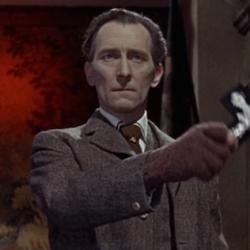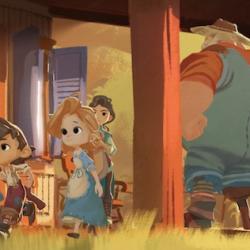I finally watched The Village . Much of it was perfectly silly. The initial explanation of the dead animals littering the village is that a coyote is on the loose, and this theory is put to rest only when it’s decided that coyotes are not big enough to leave big red marks on doors. They need medicine from “the towns” – why not send the blind girl through the woods? The stilted language and inverted syntax got irritating, and whoever told William Hurt he could act needs another line of work. How a whole village of apparently normal and normally intelligent people could fall, automaton-like, for the hoax perpetrated on them is hard to fathom.
But there were things to like: M. Night Shyamalan’s movies are always lovely to look at, and his camera is good at creating and maintaining tension. Plus, I suspect that some of what I found silly was intended allegorically (blind girl in the woods, led by love not sight) or as clues to the real origins of the villagers (the doctor appears to be Indian – from the moment he appeared I wondered how he got into the film, chasing out the thought that he was fulfilling a quota; and how’d the doctor know about alternatives to the primitive medicine he practiced in the village?; the women lead the town meetings). And the “surprise” ending that illuminates the whole and makes you rethink what you’ve been watching is well-done.
The most interesting aspects of the film for me, however, had to do with its “literary” structure and its sociology. Shyamalan does his audiences the courtesy of not explaining every detail. There is a whole back-story that he feels no need to explain through intrusive flashbacks or other clumsy narrative devices. A few clippings and photos in a locked box, with a few brief lines in voice-over are enough to hint at a background, and leave it tantalizingly undeveloped. The film ends abruptly in some respects, but any “six months later” epilogue with bright skies, a healthy Lucius, and a married Ivy would have reduced the film considerably. Contemporary film is often deadening precisely because it tells all, shows all, and leaves nothing for us to mull over afterward; Shyamalan’s movies inspire post-game conversation.
I am not certain of the direct target (if there was one) of the sociological parable, but as a general parable about anti-modernism it raises some important issues. There is the overarching irony that a community retreats from the terrors of modern life and can maintain its identity only by creating new terrors. There is a dramatic critique of the utopian impulse, a critique that, intriguingly, ends not with cynicism but with what might be taken as a chastened, realistic utopianism: The village is no longer innocent, but it is still, in the eyes of the elders at least, worth staying. Yet, the critique of the utopian impulse cuts deeper. The village has a future only because of its contact with “the towns,” but there is no indication that the elders plan to nurture Ivy’s initial contact. In the end, however, the villagers opt for a communal life based on lies, exclusions, and fear. Shyamalan apparently wants to ask, Is any other form of antimodernism available?














